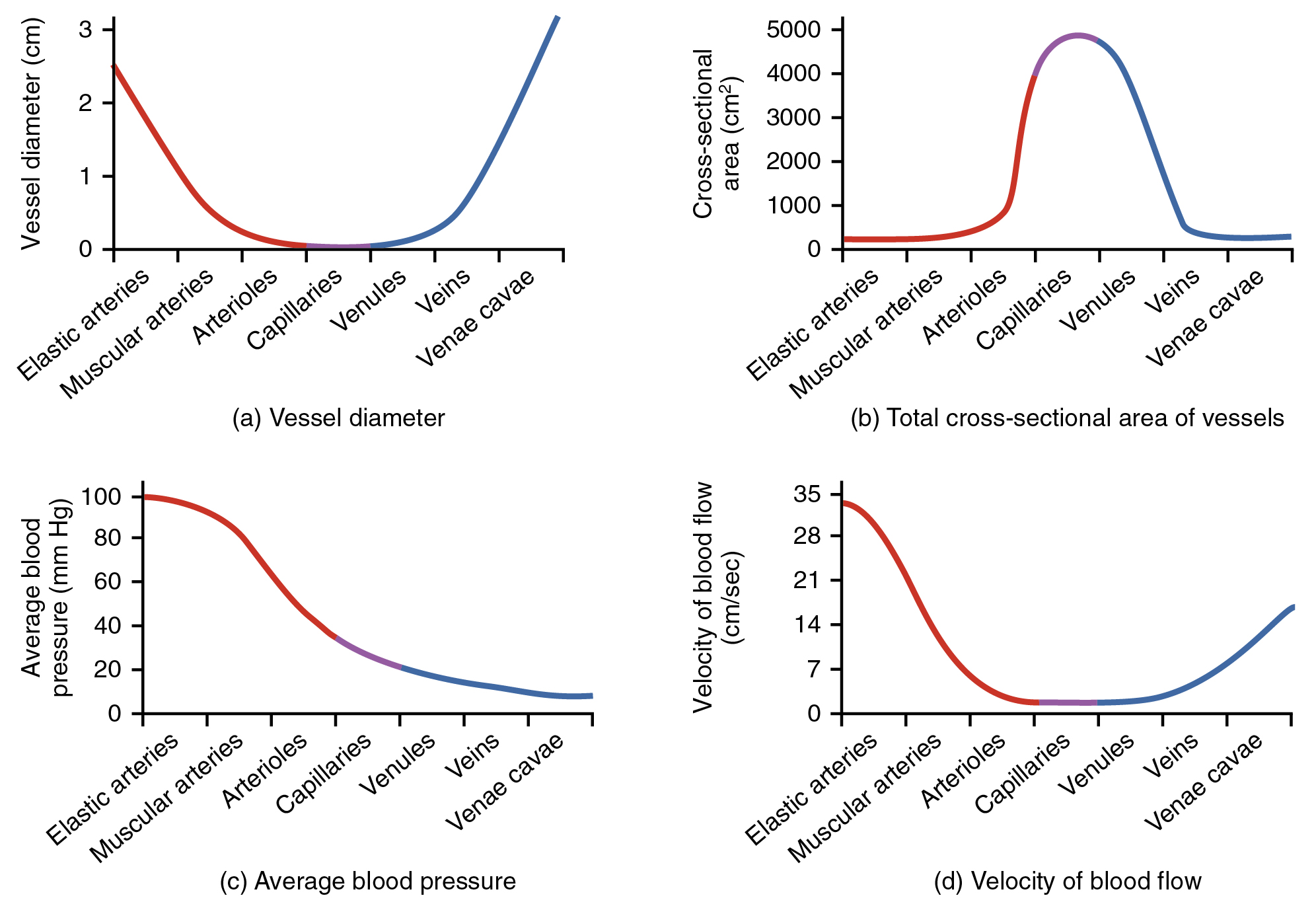55 Blood pressure graphs
Learning Objectives
At the end of this section you should be able to-
-
Interpret relevant graphs to explain the relationships between vessel diameter, cross-sectional area, blood pressure and blood velocity
-
Using a graph of pressures within the systemic circuit, interpret the pressure changes that occur in the arteries, capillaries and veins
Understanding the relationships between vessel diameter, cross-sectional area, blood pressure, and blood velocity is crucial in comprehending the dynamics of the circulatory system (Figure 55.1).

Vessel Diameter
Vessel diameter is a pivotal determinant of blood pressure regulation (Figure 55.1a). As blood travels through arteries, arterioles, capillaries, venules, and veins, alterations in vessel diameter profoundly impact blood pressure.
- Arteries and Arterioles: These vessels are closer to the heart and play a crucial role in blood pressure regulation. Arterial vessels have muscular walls that can constrict (vasoconstriction) or dilate (vasodilation) to adjust vessel diameter. When arteries constrict, their diameter decreases, leading to increased resistance to blood flow and subsequently higher blood pressure. Conversely, dilation of arteries reduces resistance, enabling easier blood flow and lowering blood pressure.
- Capillaries: Capillaries are the smallest blood vessels and the site of exchange for gases, nutrients, and waste products. Despite their tiny individual size, collectively, capillaries possess a vast total cross-sectional area. This expansion in cross-sectional area drastically reduces blood pressure. Blood slows down considerably in capillaries due to the increased total CSA, allowing for efficient exchange of substances with tissues while maintaining low pressure to prevent damage to delicate capillary walls.
- Veins: Veins, on the other hand, are vessels that return blood to the heart. They have larger lumens and thinner walls compared to arteries. Veins are less muscular and do not actively regulate diameter to the same extent as arteries. The pressure in veins is significantly lower than in arteries due to their larger total cross-sectional area and decreased resistance to blood flow.
Total Cross-Sectional Area
The total cross-sectional area refers to the collective area of all blood vessels within a specific section of the circulatory system. As blood moves from arteries to arterioles, capillaries, venules, and veins, the total cross-sectional area expands significantly, affecting blood pressure (Figure 55.1b).
- Arteries to Capillaries: Blood pressure decreases as it progresses from arteries to capillaries due to the expansive increase in total cross-sectional area. The intricate network of capillaries collectively possesses a vast surface area, allowing for efficient exchange with tissues while minimizing pressure.
- Capillaries to Veins: After the exchange at capillary beds, blood re-enters venules and veins. Although blood pressure remains relatively low in capillaries, it further decreases as blood moves into veins due to their larger total cross-sectional area. This lower pressure facilitates the return of blood to the heart while preventing backflow through the venous system.
Blood Velocity
Blood velocity, the speed at which blood flows through vessels, is inversely related to total cross-sectional area. As the total cross-sectional area increases, blood velocity decreases (Figure 55.1d).
- Arteries to Capillaries: In arteries, where the cross-sectional area is smaller, blood velocity is higher, contributing to the maintenance of systemic blood pressure. As blood flows into capillaries with their expansive total cross-sectional area, blood velocity decreases significantly. Slower blood flow in capillaries facilitates efficient exchange with tissues while maintaining low pressure.
- Capillaries to Veins: While blood velocity remains low in veins as the blood returns to the heart, it is increased compared to capillary blood velocity. The low blood velocity in larger veins aids in the prevention of backward flow and ensures efficient return of blood to the heart for recirculation.
Interpretation of Pressure Changes in the Systemic Circuit
Arteries: Pressure in arteries rises and falls cyclically with each heartbeat. Systolic pressure represents the maximum pressure during ventricular contraction, while diastolic pressure indicates the minimum pressure between heartbeats. The pulse pressure (PP), calculated as the difference between systolic and diastolic pressure, reflects the force generated by the heart. A wider pulse pressure can indicate arterial stiffness or compromised vascular function.
Capillaries: Pressure in capillaries is significantly lower than in arteries. Capillary pressure is optimized for the exchange of nutrients, gases, and waste products between blood and tissues. This low pressure prevents damage to delicate capillary walls while facilitating the diffusion of substances.
Veins: Blood pressure in veins is notably lower than in arteries. Veins function as capacitance vessels, accommodating a large volume of blood and serving as a reservoir. Valves within veins aid in maintaining blood flow against gravity, especially in the lower extremities.
Adapted from Anatomy & Physiology by Lindsay M. Biga et al, shared under a Creative Commons Attribution-ShareAlike 4.0 International License, chapter 20

